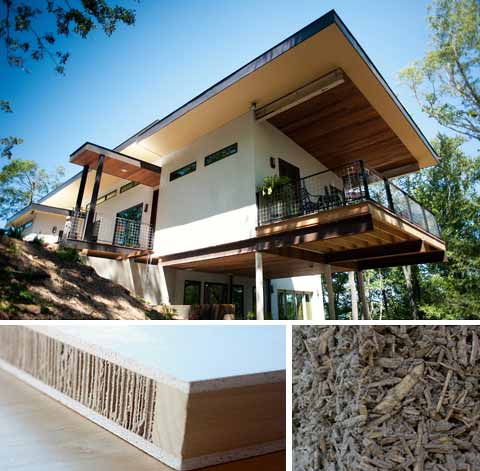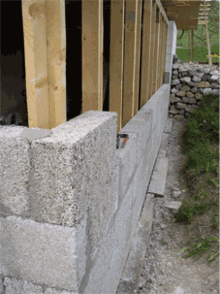Building with industrial hemp products is a way to create a
more sustainable way of life for human beings. Most Hemp building products are
carbon negative products, often regulating the air quality and keep water
issues from causing real damage in a building.
Currently being used in construction projects in countries like France, South Africa, The United Kingdom, Canada and the US, Hemp buildings have an unlimited life expectancy and cost less to construct.
Here, I have listed some of the
most common hemp building products on the market today with reasons why more
buildings should be constructed using these materials.
HempCrete
HempCrete is made by mixing hemp hurds, the interior of the
stalk, with Lime creating solid building walls lasting thousands of years. The
process was developed in France over a decade ago and has picked up in
popularity as more hemp buildings are constructed in countries all over the
World. The lime in Hempcrete is
constantly trying to turn into rock as a part of the petrifaction process. It
needs carbons to accomplish this task, so it extracts them from the air both on
the inside and outside of the building. This makes a Hempcrete wall what experts
call “a breathable wall structure”, an environmentally sustainable product with
a negative carbon foot print.
In the following video, Ian Pritchard, Chairman and Technical Director of Lime Technologies based in the UK explains how HempCrete creates a breathable wall structure.
Breathable wall structures improve air quality all around
the building. As the lime extracts carbons from the air over time, the results
are removed toxins dangerous to human beings and cleaner air all around. Airborne
allergies would decrease for those living in or around hemp buildings.
Another benefit to a hemp building is its vapor permeability.
Breathable wall structures mediate moisture issues by allowing water to escape
without causing damage. For these reasons, hemp buildings do not have mold,
mildew or dry rot, issues most common in areas of high humidity or with damp
conditions. Termites and other wood pests are not a problem, either.
The walls density is 91lbs per cubic foot making it one of
the best insulators on the market. Hemp walls change temperature very slowly,
so if the exterior temperature is fluctuating between extremes, the interior
will not be affected.
The best part of a hemp building? It’s biodegradable,
compostable and even soil enriching! Crushed up and spread over farm fields, the
lime improves the PH balance of the soil and the hemp material will break down
naturally adding to the organic qualities of the soil.
Hemp fiber boards
“The industrial hemp entrepreneurs at C&S Specialty
Builders Supply "have concluded that the best alternative to wood in
construction products is hemp. In fact, hemp has the potential to be vastly
superior to wood for everything from lumber to plywood to particle board or any
other composite construction material." C&S partners David Seber and William Conde in a published statement on the potential of building with Hemp.
The interior stalk of the hemp plant, sometimes referred to
as “hurds” can be used to make medium density fiber boards known to be stronger
than plywood made from lumber, water and fire resistant and undesirable to wood
pests such as termites or carpenter ants.
Coupled with roll out hemp insulation, walls made with these products decompose CO2 composites in the air in the same way as HempCrete described above. The most positive environmental impact of using hemp building materials, however is the decrease in deforestation and carbon producing manufacturing techniques seen today in the timber industry.
Coupled with roll out hemp insulation, walls made with these products decompose CO2 composites in the air in the same way as HempCrete described above. The most positive environmental impact of using hemp building materials, however is the decrease in deforestation and carbon producing manufacturing techniques seen today in the timber industry.
Paints and Varnishes
Hemp seed oil has been used as a base for paints and
varnishes for centuries. The 20th century saw a decline in this
manufacturing technique when humanity was plagued with the unjust enactment of
the 1937 Marihuana Tax Act prohibiting the growth or use of the hemp plant.
Petrochemical products replaced hemp seed oil and today we are paying the price
environmentally for this non-sustainable change.
Hemp Seed Oil stains, varnishes and paints are slowly making
their way back into global markets as more industrial nations repeal the
harmful laws enacted by past generations. One such product is HempShield, a
deck stain developed by Dave Seber, a long time activist, well known his role
in acclimating hemp back into American society. Developed
using materials containing only trace amounts of Volatile Organic Compounds
(VOC’s) for a product with almost no negative impact on the environment. HempShield
permeates the wood matter, leaving a coating of oil deep in the boards improving
the performance of the wood all around. Testing showed boards treated with
HempShield withstood stress tests for UV and water damage better than boards
treated with traditional petroleum based products.
Many other hemp building materials are hitting the market.
If you are considering building a home, take a look at some of the links and
videos posted below. Most contractors are able to easily substitute hemp
products with traditional ones for a more sustainable home, improving the
quality of life of those living, working on or visiting your home or business.
HempCrete Wiki
William Conde and David Seber of C&S Partners
Find Hemp Building Materials at HempTraders.com
HempShield Deck Stain
Hemp Insulation Roll
Hemp Information and News on Hemp.com
VoteHemp!
HempCrete Wiki
William Conde and David Seber of C&S Partners
Find Hemp Building Materials at HempTraders.com
HempShield Deck Stain
Hemp Insulation Roll
Hemp Information and News on Hemp.com
VoteHemp!







